Abstract
Coagulase-negative staphylococci (C-NS) are a frequent cause of bacteraemia in premature neonates. It is likely that the strains of C-NS causing bacterial sepsis in premature neonates have their origin on the patient's skin surface. We have studied the quantitative development of the skin microflora at eight sites on premature neonates. A swab wash method was used to sample and enumerate the cutaneous microflora of premature neonates admitted to an intensive care unit with respiratory distress syndrome. The numbers of bacteria present on the skin increased rapidly by 100-fold in the first week of life. The species of C-NS found on neonatal skin were similar to those found on adult skin. However, the bacterial population was 10(3) lower by comparison. There was considerable variation in numbers of bacteria and in the proportion resistant to antibiotics from day to day. There appeared to be no association between antibiotic usage and the proportion of isolates resistant to antibiotics, although the resident bacteria were in many cases resistant to a variety of antibiotics. C-NS were isolated from 92% of samples from which bacteria were isolated. Staphylococcus epidermidis was found at all sites and accounted for 82% of each colonial type of staphylococcus isolated. Other organisms isolated included Propionibacterium sp, alpha-haemolytic streptococci, aerobic spore-bearing bacilli, aerobic coryneforms, Candida albicans, Klebsiella oxytoca, Pityrosporum sp, Klebsiella pneumoniae, and Escherichia coli. The results of this study suggest that the skin of premature neonates is colonised with antibiotic resistant C-NS during the first week of life and that the chance of contamination of an intravascular catheter at insertion increases during this period.
Full text
PDF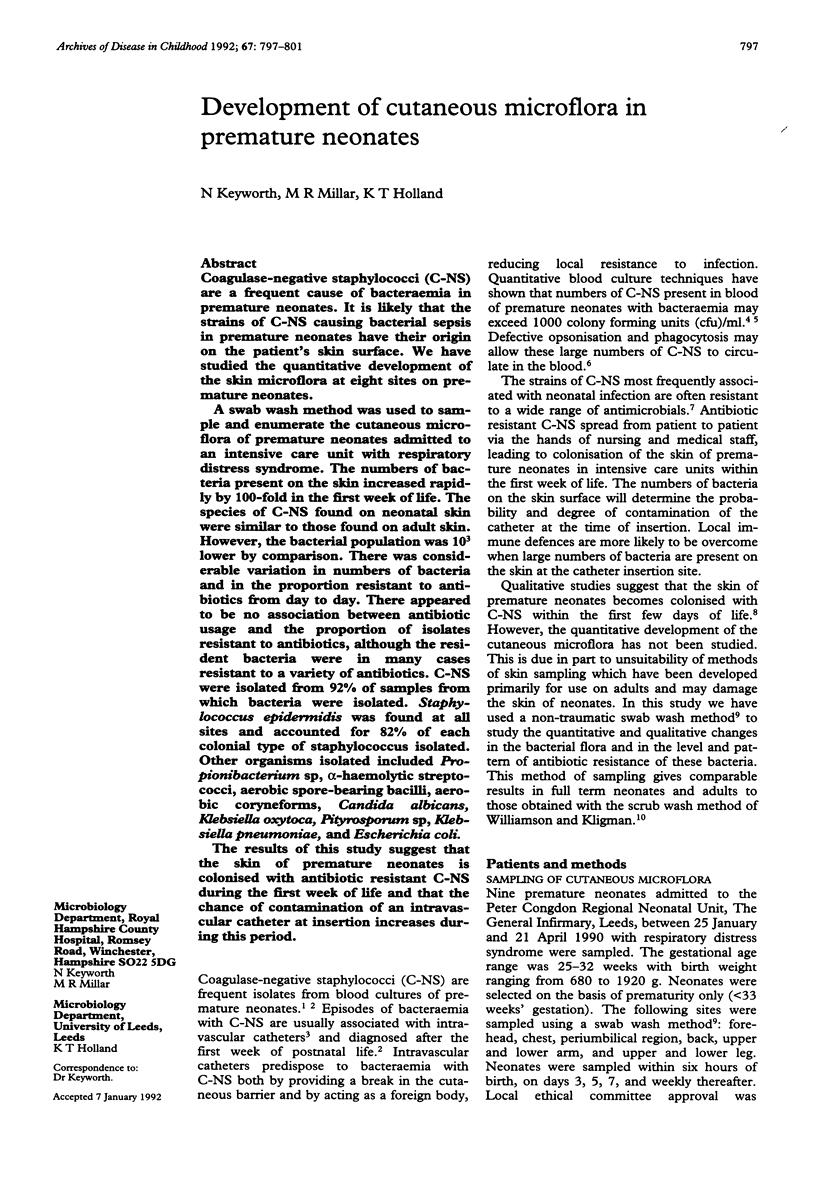
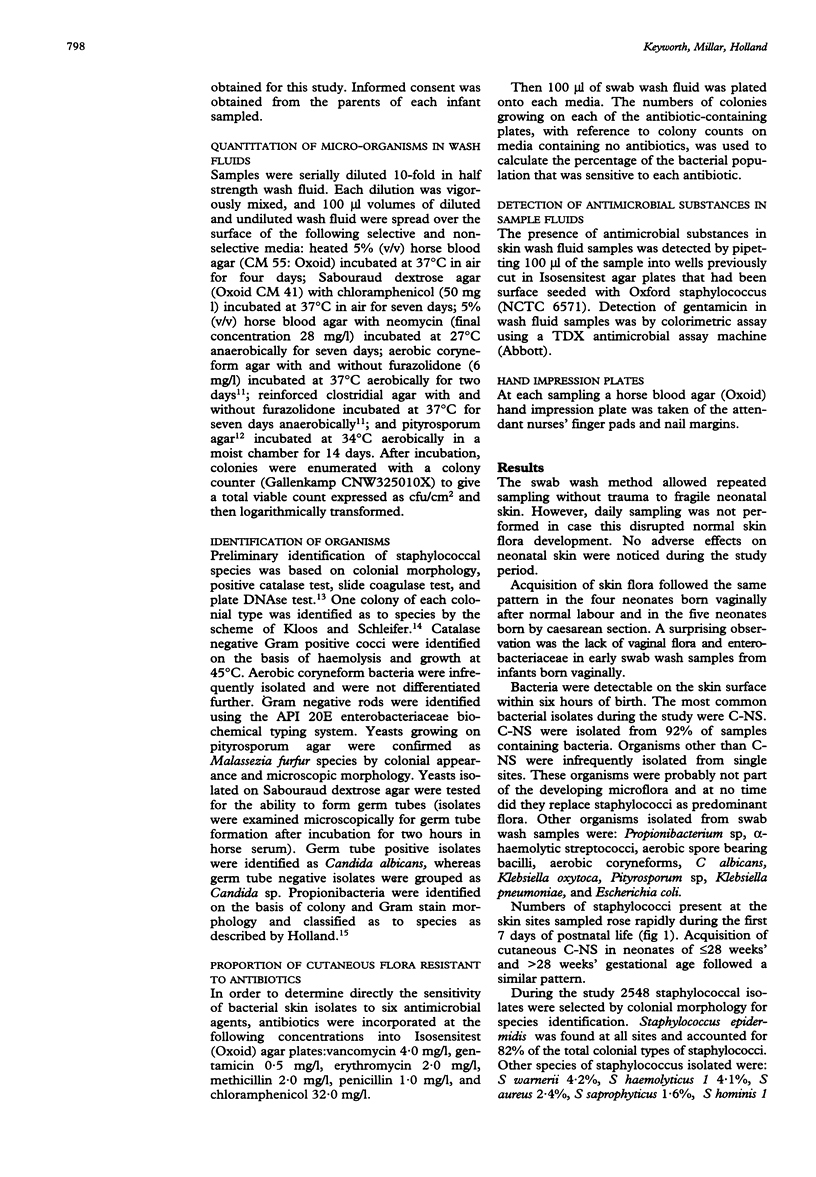
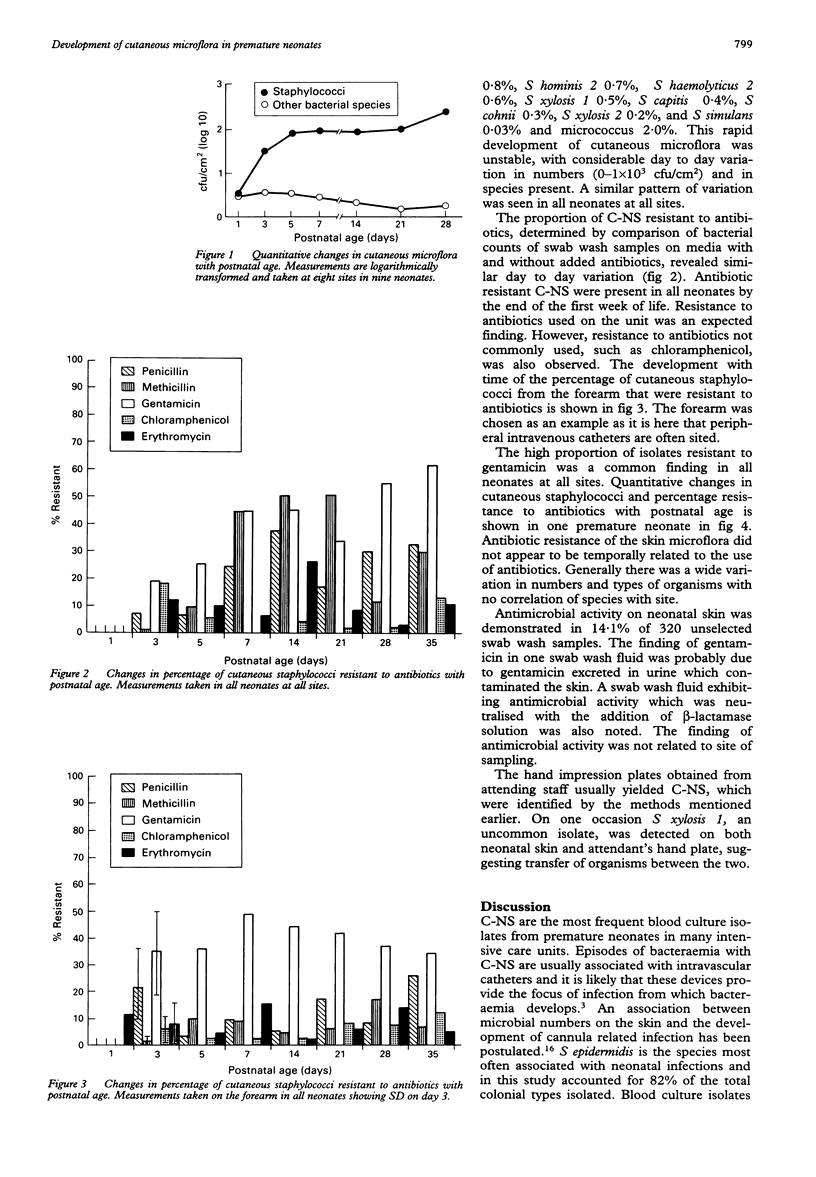
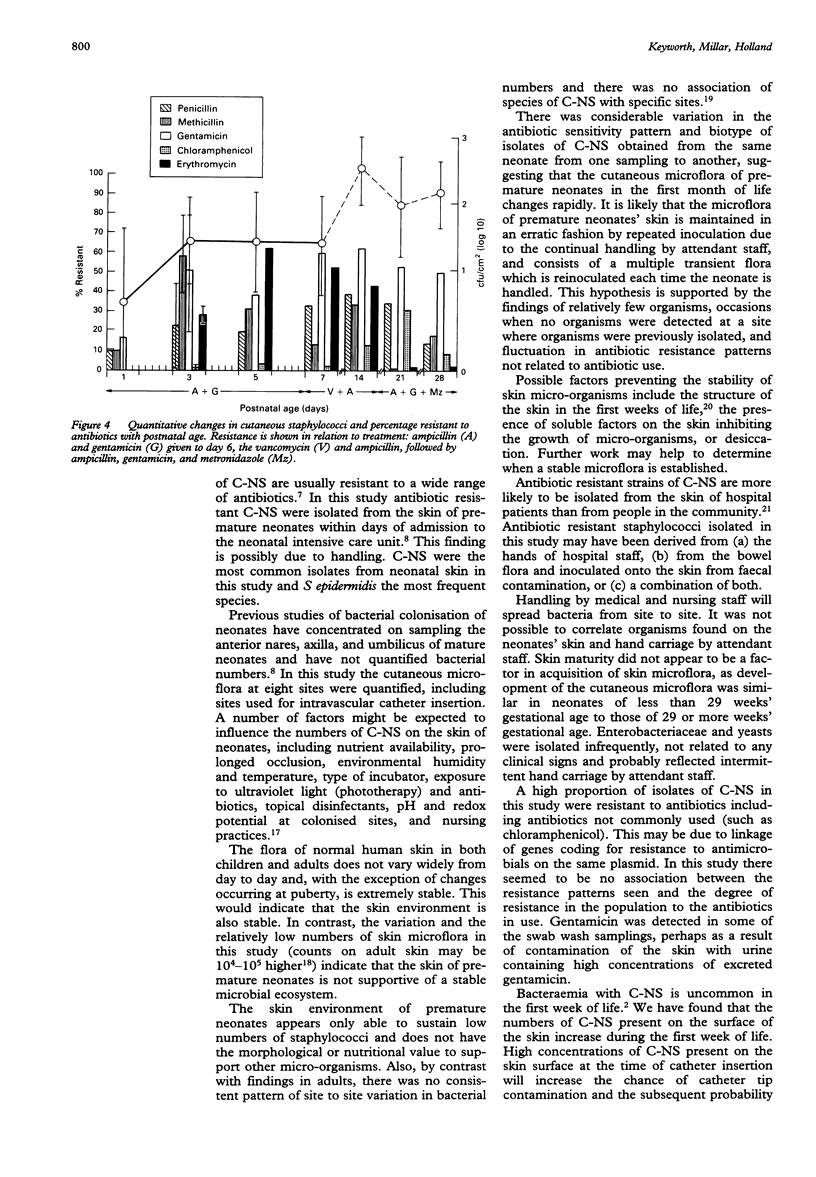
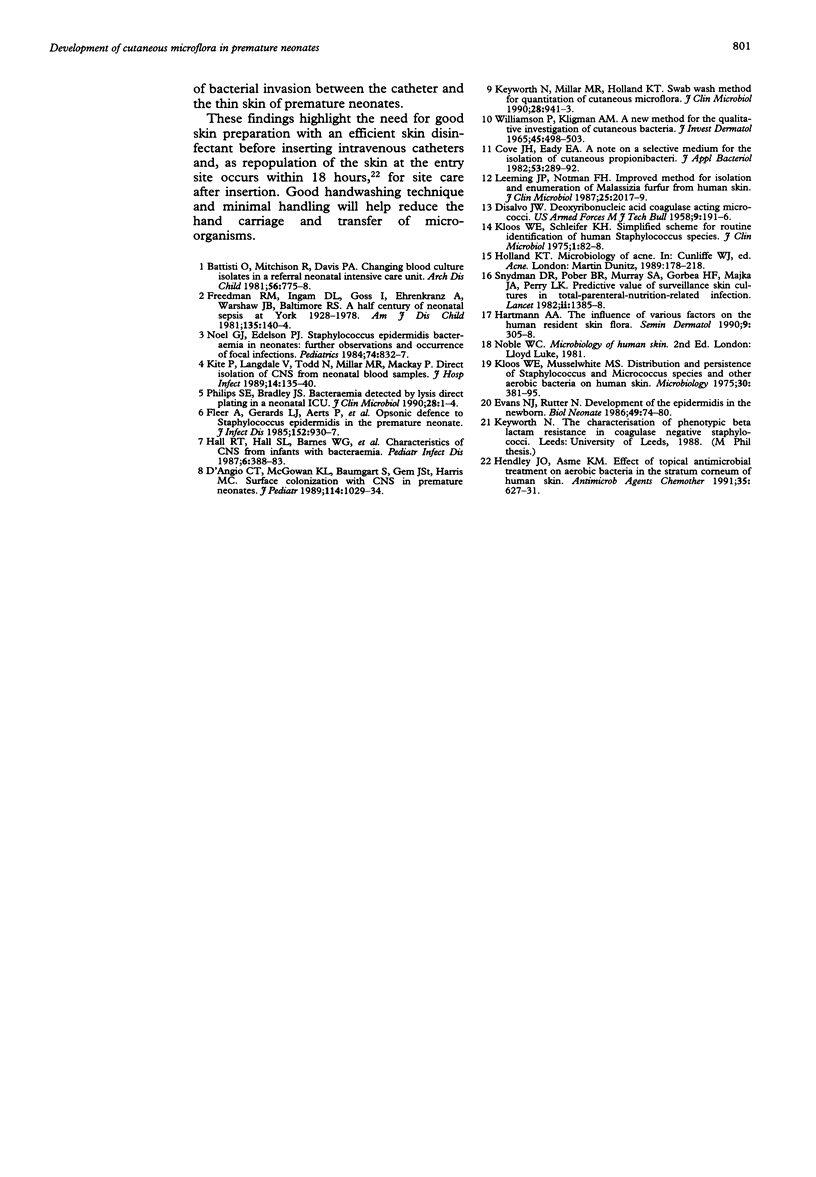
Selected References
These references are in PubMed. This may not be the complete list of references from this article.
- Battisti O., Mitchison R., Davies P. A. Changing blood culture isolates in a referral neonatal intensive care unit. Arch Dis Child. 1981 Oct;56(10):775–778. doi: 10.1136/adc.56.10.775. [DOI] [PMC free article] [PubMed] [Google Scholar]
- Cove J. H., Eady E. A. A note on a selective medium for the isolation of cutaneous propionibacteria. J Appl Bacteriol. 1982 Oct;53(2):289–292. doi: 10.1111/j.1365-2672.1982.tb04688.x. [DOI] [PubMed] [Google Scholar]
- D'Angio C. T., McGowan K. L., Baumgart S., St Geme J., Harris M. C. Surface colonization with coagulase-negative staphylococci in premature neonates. J Pediatr. 1989 Jun;114(6):1029–1034. doi: 10.1016/s0022-3476(89)80457-3. [DOI] [PubMed] [Google Scholar]
- Evans N. J., Rutter N. Development of the epidermis in the newborn. Biol Neonate. 1986;49(2):74–80. doi: 10.1159/000242513. [DOI] [PubMed] [Google Scholar]
- Fleer A., Gerards L. J., Aerts P., Westerdaal N. A., Senders R. C., van Dijk H., Verhoef J. Opsonic defense to Staphylococcus epidermidis in the premature neonate. J Infect Dis. 1985 Nov;152(5):930–937. doi: 10.1093/infdis/152.5.930. [DOI] [PubMed] [Google Scholar]
- Freedman R. M., Ingram D. L., Gross I., Ehrenkranz R. A., Warshaw J. B., Baltimore R. S. A half century of neonatal sepsis at Yale: 1928 to 1978. Am J Dis Child. 1981 Feb;135(2):140–144. doi: 10.1001/archpedi.1981.02130260032010. [DOI] [PubMed] [Google Scholar]
- Hartmann A. A. The influence of various factors on the human resident skin flora. Semin Dermatol. 1990 Dec;9(4):305–308. [PubMed] [Google Scholar]
- Hendley J. O., Ashe K. M. Effect of topical antimicrobial treatment on aerobic bacteria in the stratum corneum of human skin. Antimicrob Agents Chemother. 1991 Apr;35(4):627–631. doi: 10.1128/aac.35.4.627. [DOI] [PMC free article] [PubMed] [Google Scholar]
- Keyworth N., Millar M. R., Holland K. T. Swab-wash method for quantitation of cutaneous microflora. J Clin Microbiol. 1990 May;28(5):941–943. doi: 10.1128/jcm.28.5.941-943.1990. [DOI] [PMC free article] [PubMed] [Google Scholar]
- Kite P., Langdale V., Todd N., Millar M. R., MacKay P. Direct isolation of coagulase-negative staphylococci from neonatal blood samples. J Hosp Infect. 1989 Aug;14(2):135–140. doi: 10.1016/0195-6701(89)90116-3. [DOI] [PubMed] [Google Scholar]
- Kloos W. E., Musselwhite M. S. Distribution and persistence of Staphylococcus and Micrococcus species and other aerobic bacteria on human skin. Appl Microbiol. 1975 Sep;30(3):381–385. doi: 10.1128/am.30.3.381-395.1975. [DOI] [PMC free article] [PubMed] [Google Scholar]
- Kloos W. E., Schleifer K. H. Simplified scheme for routine identification of human Staphylococcus species. J Clin Microbiol. 1975 Jan;1(1):82–88. doi: 10.1128/jcm.1.1.82-88.1975. [DOI] [PMC free article] [PubMed] [Google Scholar]
- Leeming J. P., Notman F. H. Improved methods for isolation and enumeration of Malassezia furfur from human skin. J Clin Microbiol. 1987 Oct;25(10):2017–2019. doi: 10.1128/jcm.25.10.2017-2019.1987. [DOI] [PMC free article] [PubMed] [Google Scholar]
- Noel G. J., Edelson P. J. Staphylococcus epidermidis bacteremia in neonates: further observations and the occurrence of focal infection. Pediatrics. 1984 Nov;74(5):832–837. [PubMed] [Google Scholar]
- Phillips S. E., Bradley J. S. Bacteremia detected by lysis direct plating in a neonatal intensive care unit. J Clin Microbiol. 1990 Jan;28(1):1–4. doi: 10.1128/jcm.28.1.1-4.1990. [DOI] [PMC free article] [PubMed] [Google Scholar]
- Snydman D. R., Gorbea H. F., Pober B. R., Majka J. A., Murray S. A., Perry L. K. Predictive value of surveillance skin cultures in total-parenteral-nutrition-related infection. Lancet. 1982 Dec 18;2(8312):1385–1388. doi: 10.1016/s0140-6736(82)91281-8. [DOI] [PubMed] [Google Scholar]
- Williamson P., Kligman A. M. A new method for the quantitative investigation of cutaneous bacteria. J Invest Dermatol. 1965 Dec;45(6):498–503. doi: 10.1038/jid.1965.164. [DOI] [PubMed] [Google Scholar]


